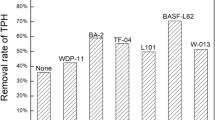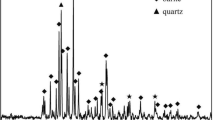Abstract
Oil-based drill cuttings (OBDCs), which contain various petroleum hydrocarbons, heavy metals, and alkaline salts, will significantly affect the local ecosystem if left untreated. Supercritical water oxidation (SCWO) is regarded as a potential end-of-pipe technology that is able to degrade organic compounds, stabilize heavy metals, and neutralize alkaline salts simultaneously. In this paper, SCWO of OBDCs was carried out using a batch reactor. Six organic compounds and eight elements were selected as representatives of the petroleum hydrocarbons and heavy metals, respectively, in OBDCs. The effects of the oxygen coefficient (OC), temperature (T), and reaction time (t) on the degradation of petroleum hydrocarbons and the stabilization of heavy metals were evaluated in detail. The results indicated that nearly 100% of naphthalenes and more than 97% of alkanes could be destroyed when T > 475 °C, t > 2 min, and OC > 2.5. The elements Ba, Cr, and Pb were almost completely stabilized in the solid products, and small amounts of Zn and Cu were detected in the liquid products. More than the original contents of Fe, Cr, and Ni were found in the solid products due to the corrosion of the SCWO reactor. The content of alkaline salt in the feed was too low to affect the pH of the liquid products. The results of X-ray diffractometer (XRD) and scanning electron microscope (SEM) analyses suggested that SCWO can efficiently remove organic pollutants from OBDCs but does not obviously affect the microstructure and composition of the inorganic compounds.







Similar content being viewed by others
References
Annevelink, M., Meesters, J., & Hendriks, A. (2016). Environmental contamination due to shale gas development. Science of the Total Environment, 550, 431–438.
ASME. (2011). Drilling fluids processing handbook. Boston: Elsevier.
Ball, A. S., Stewart, R. J., & Schliephake, K. (2012). A review of the current options for the treatment and safe disposal of drill cuttings. Waste Management & Research., 30, 457–473.
Chen, Z., Wang, G., Yin, F., Chen, H., & Xu, Y. (2015). A new system design for supercritical water oxidation. Chemical Engineering Journal., 269, 343–351.
Chen, H., Wang, G., Xu, Y., Chen, Z., & Yin, F. (2016a). Application of red mud as both neutralizer and catalyst in supercritical water oxidation (SCWO) disposal of sewage sludge. RSC Advances., 6, 54202–54214.
Chen, J., Wang, Y., Ding, S., Ding, J., Li, M., Zhang, C., & Zou, M. (2016b). Sub- and super-critical water oxidation of wastewater containing organic and heavy metallic pollutants and recovery of superfine metallic particles. Journal of Environmental Chemical Engineering., 4, 2698–2705.
Chen, Z., Chen, Z., Yin, F., Wang, G., Chen, H., He, C., & Xu, Y. (2017a). Supercritical water oxidation of oil-based drill cuttings. Journal of Hazardous Materials., 332, 205–213.
Chen, Z., Chen, Z., Chen, Q., Yao, G., Tan, Y., & Xu, Y. (2017b). Composition analysis and risk assessment of typical oil-based drill cuttings from shale gas fields. Environmental Engineering, 35, 125–129 (in Chinese).
Cui, B., Cui, F., Jing, G., Xu, S., Huo, W., & Liu, S. (2009). Oxidation of oily sludge in supercritical water. Journal of Hazardous Materials, 165, 511–517.
Cui, B., Liu, S., Cui, F., Jing, G., & Liu, X. (2011). Lumped kinetics for supercritical water oxidation of oily sludge. Process Safety and Environmental Protection, 89, 198–203.
Dong, X., Gan, Z., Lu, X., Jin, W., Yu, Y., & Zhang, M. (2015). Study on catalytic and non-catalytic supercritical water oxidation of p-nitrophenol wastewater. Chemical Engineering Journal, 277, 30–39.
Du, X., Zhang, R., Gan, Z., & Bi, J. (2013). Treatment of high strength coking wastewater by supercritical water oxidation. Fuel, 104, 77–82.
Fedyaeva, O. N., & Vostrikov, A. A. (2012). Disposal of hazardous organic substances in supercritical water. Russian Journal of Physical Chemistry B., 6, 844–860.
Gong, Y. M., Wang, S. Z., Tang, X. Y., Xu, D. H., & Ma, H. H. (2014). Supercritical water oxidation of acrylic acid production wastewater. Environmental Technology., 35, 907–916.
Gong, Y., Guo, Y., Wang, S., & Song, W. (2016). Supercritical water oxidation of quinazoline: effects of conversion parameters and reaction mechanism. Water Research, 100, 116–125.
Jin, F. M., Moriya, T., & Enomoto, H. (2003). Oxidation reaction of high molecular weight carboxylic acids in supercritical water. Environmental Science & Technology., 37, 3220–3231.
Jin, F., Zeng, X., Cao, J., Kawasaki, K., Kishita, A., Tohji, K., & Enomoto, H. (2010). Partial hydrothermal oxidation of unsaturated high molecular weight carboxylic acids for enhancing the cold flow properties of biodiesel fuel. Fuel, 89, 2448–2454.
Kogbara, R. B. (2013). A review of the mechanical and leaching performance of stabilized/solidified contaminated soils. Environmental Reviews., 22, 66–86.
Kogbara, R. B., Al-Tabbaa, A., & Stegemann, J. A. (2014). Comparisons of operating envelopes for contaminated soil stabilised/solidified with different cementitious binders. Environmental Science and Pollution Research., 21, 3395–3414.
Kogbara, R. B., Ayotamuno, J. M., Onuomah, I., Ehio, V., & Damka, T. D. (2016). Stabilisation/solidification and bioaugmentation treatment of petroleum drill cuttings. Applied Geochemistry, 71, 1–8.
Leonard, S. A., & Stegemann, J. A. (2010). Stabilization/solidification of petroleum drill cuttings. Journal of Hazardous Materials., 174, 463–472.
Liu, K., Zhang, Z., & Zhang, F. (2016). Direct extraction of palladium and silver from waste printed circuit boards powder by supercritical fluids oxidation-extraction process. Journal of Hazardous Materials., 318, 216–223.
O'Brien, C. P., Thies, M. C., & Bruce, D. A. (2005). Supercritical water oxidation of the PCB congener 2-chlorobiphenyl in methanol solutions: a kinetic analysis. Environmental Science & Technology., 39, 6839–6844.
Onwudili, J. A., & Williams, P. T. (2007). Reaction mechanisms for the decomposition of phenanthrene and naphthalene under hydrothermal conditions. Journal of Supercritical Fluids., 39, 399–408.
Robinson, J. P., Kingman, S. W., Snape, C. E., Barranco, R., Shang, H., Bradley, M. S. A., & Bradshaw, S. M. (2009). Remediation of oil-contaminated drill cuttings using continuous microwave heating. Chemical Engineering Journal., 152, 458–463.
Sánchez-Oneto, J., Portela, J. R., Nebot, E., & Martínez de la Ossa, E. (2007). Hydrothermal oxidation: application to the treatment of different cutting fluid wastes. Journal of Hazardous Materials., 144, 639–644.
Shin, Y. H., Lee, H.-S., Lee, Y.-H., Kim, J., Kim, J.-D., & Lee, Y.-W. (2009). Synergetic effect of copper-plating wastewater as a catalyst for the destruction of acrylonitrile wastewater in supercritical water oxidation. Journal of Hazardous Materials., 167, 824–829.
Watanabe, M., Mochiduki, M., Sawamoto, S., Adschiri, T., & Arai, K. (2001). Partial oxidation of n-hexadecane and polyethylene in supercritical water. Journal of Supercritical Fluids., 20, 257–266.
Xiu, F.-R., Qi, Y., & Zhang, F.-S. (2015). Leaching of Au, Ag, and Pd from waste printed circuit boards of mobile phone by iodide lixiviant after supercritical water pre-treatment. Waste Management., 41, 134–141.
Xu, D., Huang, C., Wang, S., Lin, G., & Guo, Y. (2015). Salt deposition problems in supercritical water oxidation. Chemical Engineering Journal., 279, 1010–1022.
Yan, P., Lu, M., Guan, Y., Zhang, W., & Zhang, Z. (2011). Remediation of oil-based drill cuttings through a biosurfactant-based washing followed by a biodegradation treatment. Bioresource technology., 102, 10252–10259.
Yoko, A., & Oshima, Y. (2013). Recovery of silicon from silicon sludge using supercritical water. Journal of Supercritical Fluids., 75, 1–5.
Zhang, S., Zhang, Z., Zhao, R., Gu, J., Liu, J., Ormeci, B., & Zhang, J. (2017). A review of challenges and recent progress in supercritical water oxidation of wastewater. Chemical Engineering Communications., 204, 265–282.
Zou, D., Chi, Y., Dong, J., Fu, C., Wang, F., & Ni, M. (2013a). Supercritical water oxidation of tannery sludge: stabilization of chromium and destruction of organics. Chemosphere, 93, 1413–1418.
Zou, D., Chi, Y., Fu, C., Dong, J., Wang, F., & Ni, M. (2013b). Co-destruction of organic pollutants in municipal solid waste leachate and dioxins in fly ash under supercritical water using H2O2 as oxidant. Journal of Hazardous Materials., 248–249, 177–184.
Zou, D., Chi, Y., Dong, J., Fu, C., & Ni, M. (2014). Supercritical water oxidation of MSW leachate: factor analysis and behavior of heavy metals. Environmental Progress & Sustainable Energy., 33, 1117–1124.
Funding
This work was financially supported by the fundamental and frontier planning program of Chongqing (cstc2015jcyjA20010), the science and technology planning program of Land Resource and House Management Office of Chongqing (CQGT-KJ-2014040), and the Open Project Program of State Key Laboratory of Petroleum Pollution Control (PPC2016001), CNPC Research Institute of Safety and Environmental Technology.
Author information
Authors and Affiliations
Corresponding authors
Rights and permissions
About this article
Cite this article
Yao, G., Chen, Z., Chen, Q. et al. Behaviors of Organic and Heavy Metallic Pollutants during Supercritical Water Oxidation of Oil-Based Drill Cuttings. Water Air Soil Pollut 229, 102 (2018). https://doi.org/10.1007/s11270-018-3751-z
Received:
Accepted:
Published:
DOI: https://doi.org/10.1007/s11270-018-3751-z




